News
Las Vegas Not Oakland Raiders NFL Stadium Ready, Here’s Why

Las Vegas is not ready for the Oakland Raiders, nor does it have an NFL Stadium plan. And by “Las Vegas,” this Zennie62.com Zennie Abraham / Zennie62 on YouTube Oakland Post video-blogger means Clark County, Nevada, and the people in charge of leading the effort to draw the Silver and Black away from Oakland.
Fans of the idea of the Oakland Raiders in Las Vegas got really excited when the NFL team’s owner Mark Davis officially filed with the National Football League to relocate to Sin City on Thursday of last week (ironically on the date of the famous “Tuck Rule” NFL Divisional Playoff game that the Raiders lost to the New England Patriots).
Those Vegas fans insisted that the Raiders move to Las Vegas was a “done deal” as some like to tweet from time to time. In point of fact, it’s anything but, and just a look reveals that not only is it not a done deal, but that the Las Vegas planners have a long way to go before they can crow about being ready for the Raiders. That doesn’t come from this blogger’s imagination, but the very Las Vegas Review-Journal itself – the same media organization owned by the family of Las Vegas Sands Founder and CEO Sheldon Adelson. Yes, the same Mr. Adelson who, almost exactly one year ago, began his partnership with Mr. Davis in forming the Raiders-to-Las Vegas plan.
What the Review-Journal did was assemble, in one neat but not-complete package, why Las Vegas isn’t ready – and echoed everything this blogger has said to anyone who would not listen. Let’s take the reasons as a list, and I will add more reasons based on how the Stadium Authority’s enabling legislation was written, and the common steps associated with NFL stadium development.
1. The Las Vegas Stadium Authority is still, as of this writing, in formation. In fact, it’s still so new, it hasn’t even picked out a law firm to represent it, and just installed its newest board member on January 12th.
2. There’s no developer. The initial Las Vegas Sands / Oakland Raiders partnership included Majestic Realty as a third partner – and they were to add a $150 million investment. But on September 13th of 2016, Majestic announced it was leaving the deal, saying that Mr. Adelson wanted to pay for the remainder of the stadium cost himself as a “legacy project.”
3. There’s no Mark Davis deal with Mr. Adelson and Las Vegas Sands. To date, what was expected by some to be smooth sailing to a deal after the Nevada Legislature was strong-armed by Adelson’s deputies (some would say bullied) into passing the controversial $750 million subsidy (with a very tight and unheard of 1.5-to-1 debt coverage ratio), has been anything but. Adelson went public, saying that he could walk away from a plan with Davis if he didn’t get what he wanted. Davis, in turn, let the media float an alternative plan that would remove Adelson and his $800 million investment ($650 million plus the $150 millon gap left when Majestic backed out) – in place was Davis’ questionable claim that Goldman Sachs would finance the monetary hole left in Adelson’s wake, but implying that the investment banking firm would be the investor replacing Adelson. (Questionable because Goldman Sachs does not invest it’s own money in stadiums – just provides financing based on expected cash flows from identified stadium development-related sources.)
4. There’s no named and identified replacement investor for Sheldon Adelson, even with claims that one exists out there, somewhere, no real name or organization has been identified.
5. There’s no deal agreement with the alternative investor to Sheldon Adelson.
6. Because of 3, 4, and 5, there’s no proposed term sheet.
7. Because of 3, 4, and 5, there’s no stadium lease agreement.
8. Because of 3, 4, and 5, the NFL has not weighed in with its opinion.
9. There’s no stadium land deal in place. The Review-Journal explains what many have known for months: that, to quote “64 acres on four parcels bordered by Russell Road, Hacienda Avenue, Polaris Avenue and Dean Martin Drive. It’s just west of Interstate 15 and the Mandalay Bay resort. The Raiders reportedly have an option to buy the unoccupied land.”
10. According to the Nevada legislation enabling the Las Vegas Stadium Authority, once the land is selected, the stadium authority still has to vote to approve it. Moreover, there are other competing ideas for the placement of the stadium, including the reported “67 acres between Las Vegas Boulevard and I-15, just north of Blue Diamond Road” according to the Review-Journal, and the Cashman Site near Downtown Las Vegas, which Las Vegas Mayor Goodman has long favored.
11. Who pays for the $1 billion stadium transportation infrastructure plan that was released by the Nevada Department of Transportation on October 4th of 2016? That plan was hidden from media view and from much of the Nevada Legislature until October 10th, and during the deliberations around the subsidy – news that came close to killing the votes for the bond issue that Las Vegas Sands lobbyists worked overtime to get.
12. Once the Las Vegas Stadium Authority get to the point of approving a deal, if one ever comes to fruition, The Clark County Board Of Commissioners still has to approve the permits and possible needed zoning changes to build the stadium at whatever site is selected. The stadium authority’s legislation does not give it power to totally circumvent Clark County’s Board. In development matters – the authority’s primary role is that of a fiscal agent for the stadium bond issue.
13. Who pays for the $550 million relocation fee from Oakland to Las Vegas? Even at ten years, it still comes to $55 million annually, and thus The Raiders run into the same problem that reared its head in the Carson case last year: the Oakland Raiders have not had net operating incomes over $44 million at any time in the 21st Century. Adding an annual $55 million hit from a $550 million relocation fee (not including interest) drives the team into the red each year.
14. Where does UNLV fit in the Raiders stadium agreement plan? Will the Raiders agree in writing to let UNLV use the stadium rent free, perhaps as a tax-write-off? Will that amount be enough to offset the stadium operating costs for UNLV games the Raiders would eat?
Those are the primary issues outstanding that put Las Vegas, in total, light years behind where Oakland is. Oakland has an investor in The Lott Group and Fortress Investments, land that does not need to be approved for rezoning, a stadium term sheet, approved use of the land via a general plan approved in 2015, an already financed infrastructure plan, a transportation system that does not need to be expanded or upgraded, let alone paid for, and because it’s the Raiders home, no need for a $550 million relocation fee.
Oh, and Oakland has a built-in fan base called Raider Nation that drove a season ticket sellout in 2016 and produced many game ticket sellouts when the team was posting losing seasons.
With all that, why are the Raiders even trying to move to Las Vegas? And why doesn’t the NFL point out just how far Las Vegas really has to go? NFL Stadium point person Eric Grubman has said that the Raiders don’t need to fill out a proposal to file a relocation fee, but once does, their proposal will undergo NFL scrutiny, and soon. Still, Grubman should weigh in on Las Vegas’ many problems to date.
With Las Vegas having so many problems, Grubman is right to tell Oakland officials that it’s task is to form a stadium plan, and not an answer to Sin City. Oakland Mayor Libby Schaaf needs to shift her words to avoid using terms like “competitive” and because Vegas has nothing to compete against. But what the NFL wants Oakland to do is compete against the state of stadium development art. To take this deal to the next level. In the near future, I’ll explain what that looks like.
Stay tuned.
Alameda County
Seth Curry Makes Impressive Debut with the Golden State Warriors
Seth looked comfortable in his new uniform, seamlessly fitting into the Warriors’ offensive and defensive system. He finished the night with an impressive 14 points, becoming one of the team’s top scorers for the game. Seth’s points came in a variety of ways – floaters, spot-up three-pointers, mid-range jumpers, and a handful of aggressive drives that kept the Oklahoma City Thunder defense on its heels.
By Y’Anad Burrell
Tuesday night was anything but ordinary for fans in San Francisco as Seth Curry made his highly anticipated debut as a new member of the Golden State Warriors. Seth didn’t disappoint, delivering a performance that not only showcased his scoring ability but also demonstrated his added value to the team.
At 35, the 12-year NBA veteran on Monday signed a contract to play with the Warriors for the rest of the season.
Seth looked comfortable in his new uniform, seamlessly fitting into the Warriors’ offensive and defensive system. He finished the night with an impressive 14 points, becoming one of the team’s top scorers for the game. Seth’s points came in a variety of ways – floaters, spot-up three-pointers, mid-range jumpers, and a handful of aggressive drives that kept the Oklahoma City Thunder defense on its heels.
One of the most memorable moments of the evening came before Seth even scored his first points. As he checked into the game, the Chase Center erupted into applause, with fans rising to their feet to give the newest Warrior a standing ovation.
The crowd’s reaction was a testament not only to Seth’s reputation as a sharpshooter but also to the excitement he brings to the Warriors. It was clear that fans quickly embraced Seth as one of their own, eager to see what he could bring to the team’s championship aspirations.
Warriors’ superstar Steph Curry – Seth’s brother – did not play due to an injury. One could only imagine what it would be like if the Curry brothers were on the court together. Magic in the making.
Seth’s debut proved to be a turning point for the Warriors. Not only did he contribute on the scoreboard, but he also brought a sense of confidence and composure to the floor.
While their loss last night, OKC 124 – GSW 112, Seth’s impact was a game-changer and there’s more yet to come. Beyond statistics, it was clear that Seth’s presence elevated the team’s performance, giving the Warriors a new force as they look to make a deep playoff run.
#NNPA BlackPress
LIHEAP Funds Released After Weeks of Delay as States and the District Rush to Protect Households from the Cold
BLACKPRESSUSA NEWSWIRE — The federal government has released $3.6 billion in home heating assistance after a delay that left states preparing for the start of winter without the program’s annual funding.

By Stacy M. Brown
Black Press USA Senior National Correspondent
The federal government has released $3.6 billion in home heating assistance after a delay that left states preparing for the start of winter without the program’s annual funding. The Low-Income Home Energy Assistance Program, known as LIHEAP, helps eligible households pay heating and cooling bills. The release follows a shutdown that stretched 43 days and pushed agencies across the country to warn families of possible disruptions.
State officials in Minnesota, Kansas, New York, and Pennsylvania had already issued alerts that the delay could slow the processing of applications or force families to wait until December for help. In Pennsylvania, more than 300,000 households depend on the program each year. Minnesota officials noted that older adults, young children, and people with disabilities face the highest risk as temperatures fall.
The delay also raised concerns among advocates who track household debt tied to rising utility costs. National Energy Assistance Directors Association Executive Director Mark Wolfe said the funds were “essential and long overdue” and added that high arrearages and increased energy prices have strained families seeking help.
Some states faced additional pressure when other services were affected by the shutdown. According to data reviewed by national energy advocates, roughly 68 percent of LIHEAP households also receive nutrition assistance, and the freeze in multiple programs increased the financial burden on low-income residents. Wolfe said families were placed in “an even more precarious situation than usual” as the shutdown stretched into November.
In Maryland, lawmakers urged the Trump administration to release funds after the state recorded its first cold-related death of the season. The Maryland Department of Health reported that a man in his 30s was found outdoors in Frederick County when temperatures dropped. Last winter, the state documented 75 cold-related deaths, the highest number in five years. Rep Kweisi Mfume joined more than 100 House members calling for immediate federal action and said LIHEAP “is not a luxury” for the 100,000 Maryland households that rely on it. He added that seniors and veterans would be placed at risk if the program remained stalled.
Maryland Gov. Wes Moore used $10.1 million in state funds to keep benefits moving, but noted that states cannot routinely replace federal dollars. His administration said families that rely on medical equipment requiring electricity are particularly vulnerable.
The District of Columbia has already mapped out its FY26 LIHEAP structure in documents filed with the federal government. The District’s plan shows that heating assistance, cooling assistance, weatherization, and year-round crisis assistance operate from October 1 through September 30. The District allocates 50 percent of its LIHEAP funds to heating assistance, 10 percent to cooling, 13 percent to year-round crisis assistance, 15 percent to weatherization, and 10 percent to administrative costs. Two percent is used for services that help residents reduce energy needs, including education on reading utility bills and identifying energy waste.
The District’s plan lists a minimum LIHEAP benefit of $200 and a maximum of $1,800 for both heating and cooling assistance. Crisis benefits are provided separately and may reach up to $500 when needed to resolve an emergency. The plan states that a household is considered in crisis if it has been disconnected from energy service, if heating oil is at 5 percent or less of capacity, or if the household has at least $200 owed after the regular benefit is applied.
The District’s filing notes that LIHEAP staff conduct outreach through community meetings, senior housing sites, Advisory Neighborhood Commissions, social media, posters, and mass mailings. The plan confirms that LIHEAP applicants can apply in person, by mail, by email, or through a mobile-friendly online application and that physically disabled residents may request in-home visits.
As agencies nationwide begin distributing the newly released funds, states continue working through large volumes of applications. Wolfe said LIHEAP administrators “have been notified that the award letters have gone out and the states can begin to draw down the funds.”
#NNPA BlackPress
Seven Steps to Help Your Child Build Meaningful Connections
BLACKPRESSUSA NEWSWIRE — Swinging side by side with a friend on the playground. Sharing chalk over bright, colorful sidewalk drawings. Hiding behind a tree during a spirited game of hide-and-seek. These simple moments between children may seem small, but they matter more than we think

By Niyoka McCoy, Ed.D., Chief Learning Officer, Stride/K12
Swinging side by side with a friend on the playground. Sharing chalk over bright, colorful sidewalk drawings. Hiding behind a tree during a spirited game of hide-and-seek. These simple moments between children may seem small, but they matter more than we think: They lay the foundation for some of life’s most important skills.
Through everyday play, young children begin learning essential social and emotional skills like sharing, resolving conflicts, showing empathy, and managing their emotions. These social skills help shape emotional growth and set kids up for long-term success. Socialization in early childhood isn’t just a “nice-to-have”—it’s essential for development.
Yet today, many young children who haven’t yet started school aren’t getting enough consistent, meaningful interaction with peers. Research shows that there’s a decline in active free play and peer socialization when compared to previous generations.
There are many reasons for this. Children who are home with a parent during the day may spend most of their time with adults, limiting opportunities for peer play. Those in daycare or preschool may have restricted free play, and large classrooms can reduce supervision and social coaching. Some children live in rural areas, are homebound due to illness, have full schedules, or rely on screens to fill their playtime. And for some families, finding other families with young children to connect with isn’t easy.
While these challenges can feel significant, opportunities for connection still exist in every community. Families can take simple steps to help children build friendships, create a sense of belonging, and strengthen social skills. Here are some ideas to get started:
- Storytime sessions at libraries or local bookstores
- Community offerings such as parent-child workshops, art, music, gymnastics, swimming, or sports programs
- Weekly events at children’s museums, which may include art projects, music workshops, or science experiments
- Outdoor exploration, where kids can play with peers
- Local parenting groups that organize playdates and group activities
- Volunteer opportunities where children can participate, such as pet adoption events or packing meals at a food bank
- Classes for kids at local businesses, including hardware, grocery, or craft stores
Some of these community activities are free or low-cost and give kids the chance to build friendships and practice social skills. Parents can also model positive social behavior by interacting with other parents and encouraging their children to play with their peers.
These may seem like small moments of connection, but they can have a powerful impact. Every time your child shares a toy, plays make-believe with peers, or races a friend down the slide, they’re not just playing—they’re learning the skills that build confidence, empathy, and lasting friendships. And it’s good for you, too. Creating intentional opportunities for play also helps you strengthen your own network of parents who can support one another as your children grow together.
-
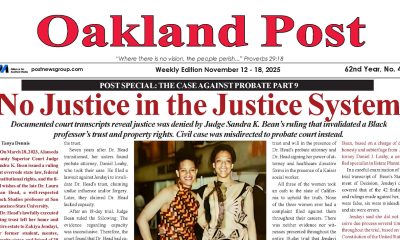
 Activism3 weeks ago
Activism3 weeks agoOakland Post: Week of November 12 – 18, 2025
-
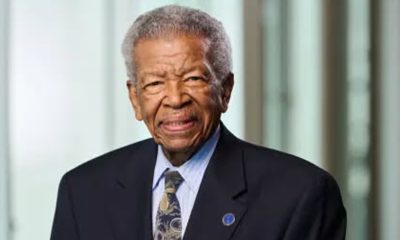
 Activism3 weeks ago
Activism3 weeks agoIN MEMORIAM: William ‘Bill’ Patterson, 94
-

 Activism3 weeks ago
Activism3 weeks agoHow Charles R. Drew University Navigated More Than $20 Million in Fed Cuts – Still Prioritizing Students and Community Health
-

 Bay Area3 weeks ago
Bay Area3 weeks agoNo Justice in the Justice System
-

 #NNPA BlackPress3 weeks ago
#NNPA BlackPress3 weeks agoLewis Hamilton set to start LAST in Saturday Night’s Las Vegas Grand Prix
-

 #NNPA BlackPress2 weeks ago
#NNPA BlackPress2 weeks agoBeyoncé and Jay-Z make rare public appearance with Lewis Hamilton at Las Vegas Grand Prix
-
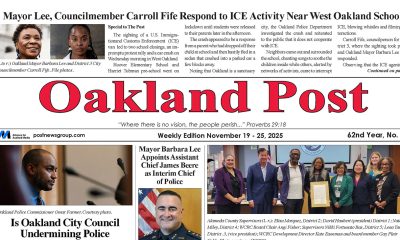
 Activism2 weeks ago
Activism2 weeks agoOakland Post: Week of November 19 – 25, 2025
-

 #NNPA BlackPress3 weeks ago
#NNPA BlackPress3 weeks agoThe Perfumed Hand of Hypocrisy: Trump Hosted Former Terror Suspect While America Condemns a Muslim Mayor

